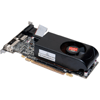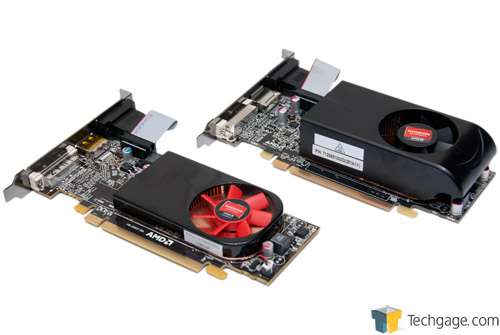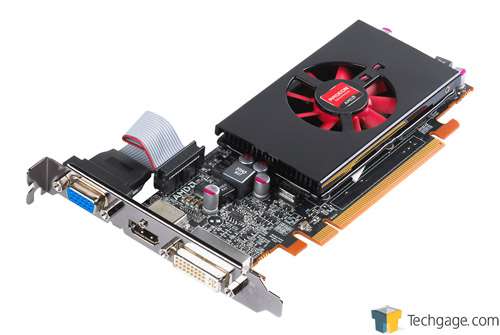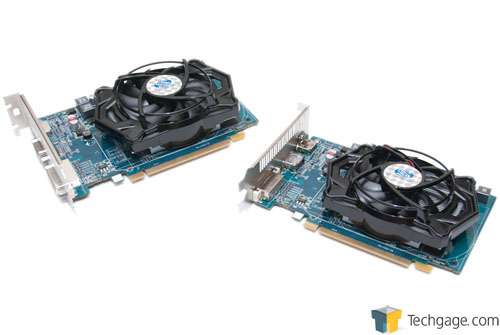- Qualcomm Launches Snapdragon 4 Gen 2 Mobile Platform
- AMD Launches Ryzen PRO 7000 Series Mobile & Desktop Platform
- Intel Launches Sleek Single-Slot Arc Pro A60 Workstation Graphics Card
- NVIDIA Announces Latest Ada Lovelace Additions: GeForce RTX 4060 Ti & RTX 4060
- Maxon Redshift With AMD Radeon GPU Rendering Support Now Available
AMD’s Sub-$100 Line-up: Radeon HD 6450, 6570 & 6670 Review

Rounding out its Radeon HD 6000 series, AMD this month launched three sub-$100 graphics cards; the $55 HD 6450; the $79 HD 6570 and the $99 HD 6670. Despite being low-end options, all three support Eyefinity and are of course, extremely power efficient. Let’s see if they also have the gaming performance to boot.
Page 1 – Introduction
Since the beginning of the year, AMD has been working to fill out the rest of its Radeon HD 6000 line-up, and thanks to today’s launch of both the HD 6570 and HD 6670 cards, the company has effectively plugged all of the remaining gaps.
Well… we all know how that goes; but with eight models ranging in price from $55~$350, the next thing we’ll likely see are price drops, rather than new models. In this article, we’ll also be taking a look at the HD 6450 released a couple of weeks ago, as we haven’t had a chance to tackle it until now.
Before diving head-first into things, I do want to mention that this article isn’t going to be quite as in-depth as I’d like it, as I’ve been juggling many different things lately in order to whittle down the queue I have built up; the foremost project being our motherboard test suite overhaul.
As a result, I’m not going to rehash what AMD has told us numerous times before, but rather take a look at the cards from their gaming perspective only. We already know that AMD’s offerings can handle things like media viewing with ease, Eyefinity and other features, so we’d simply be redundant to talk about that all again. With that said, let’s get right into things!
|
Model
|
Core MHz
|
Mem MHz
|
Memory
|
Bus Width
|
Processors
|
| Radeon HD 6990 |
830
|
1250
|
4096MB
|
256-bit
|
3072
|
| Radeon HD 6970 |
880
|
1350
|
2048MB
|
256-bit
|
1536
|
| Radeon HD 6950 |
800
|
1250
|
2048MB
1024MB |
256-bit
|
1408
|
| Radeon HD 6870 |
900
|
1050
|
1024MB
|
256-bit
|
1120
|
| Radeon HD 6850 |
775
|
1000
|
1024MB
|
256-bit
|
960
|
| Radeon HD 6790 |
840
|
1050
|
1024MB
|
256-bit
|
800
|
| Radeon HD 6670 |
800
|
1000
|
1024MB
|
128-bit
|
480
|
| Radeon HD 6570 |
650
|
1000 (GDDR5)
900 (DDR3) |
512MB
|
128-bit
|
480
|
| Radeon HD 6450 |
625-750
|
800-900 (GDDR5)
533-800 (DDR3) |
1024MB
|
64-bit
|
160
|
The Radeon HD 6570 and HD 6670 are for the most part, identical, with small changes. The HD 6670 has a faster core and memory frequency, and also has more memory – at least, according to the configurations we were given. It can be assumed that the most common HD 6570 config will be 512MB, and 1GB for the HD 6670. For the HD 6570, vendors can opt to use DDR3 in order to offer a lower-power and lower-priced option.
The HD 6450 can also be made available in both DDR3 and GDDR5 flavors, and can feature wildly varying clock speeds; 625~750MHz. The latter of which is what we’ll be benchmarking today.
Speaking of, here are some shots of the reference boards; the HD 6450 and HD 6670 (top) being our photo, and the HD 6570 (bottom) being AMD’s (we received our sample with a cooler AMD didn’t want shown off):
Sapphire also sent us along its vision of the HD 6570 and HD 6670, which look to us as being a leap above the reference design:
AMD’s quoted to us a $79 USD price tag for the HD 6570, and a $99 one for the HD 6670, which Sapphire backed up to us prior to publishing with regards to its own cards. Given that Sapphire’s cards offer a far-improved GPU cooler, it’s nice to know that the pricing will remain on par with AMD’s MSRP.
We benchmarked all three of these cards across a 1680×1050 resolution, using the same settings that we normally use. While this is going to showcase some extremely poor performance on behalf of the cards, it does show the proper scaling of the cards, and also give you an idea of how much more performance could be had with a $100+ offering.
Also, due to our StarCraft II patcher not agreeing with us, we were forced to drop that from our testing. So with that said, let’s get a move on!
Support our efforts! With ad revenue at an all-time low for written websites, we're relying more than ever on reader support to help us continue putting so much effort into this type of content. You can support us by becoming a Patron, or by using our Amazon shopping affiliate links listed through our articles. Thanks for your support!








